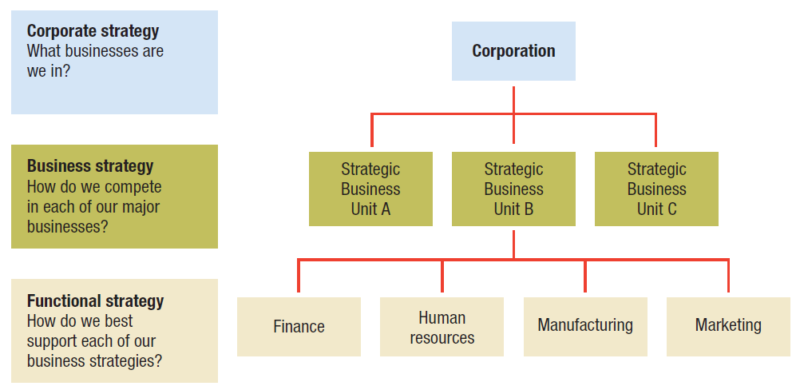The word “strategy” or “strategic” is used in both terms, there is a possibility of confusion. The distinction is that strategy formulation is the process of deciding on new strategies, whereas strategic planning is the process of deciding how to implement the strategies. In the strategy formulation process, management arrives at the goals of the organization and creates the main strategies for achieving those goals. The strategic planning process then takes the goals and strategies as given and develops programs that will carry out the strategies and achieve the goals efficiently and effectively, The decision by an industrial goods manufacturer to diversify into consumer goods is a strategy formulation, a strategic decision, after which a number of implementation issues have to be resolved: whether to diversify through acquisition or through organic growth, what product lines to emphasize, whether to make or to buy, which marketing channels to use the document Continue reading
Strategic Management Basics
Sources of Attaining Competitive Advantage by a Business Firm
When a firm sustains profits that exceed the average for its industry, the firm is said to possess a competitive advantage over its rivals. A competitive advantage is an advantage over competitors gained by offering consumers greater value, either by means of lower prices or by providing greater benefits and service that justifies higher prices. Competitive advantages are capabilities that are difficult to replicate or imitate and are non-tradable. Pitts and Snow define a competitive advantage as “any feature of a business firm that enables it to earn a high return on investment despite counter pressure from competitors.” A competitive advantage exists when the firm is able to deliver the same benefits as the competitors are but at a lower cost (cost advantage), or deliver benefits that exceed those of competing products (differentiation advantage). Thus, a competitive advantage enables a firm to create superior value for its customers and superior Continue reading
3 Levels of Business Strategy Hierarchy
A strategy is the model or plan that incorporates an organization’s main policies, action progressions, and goals into a dependable whole. Besides that, it is the way and compass of an organization long time ago, which accomplished improvement for the organization during its pattern of resources contained by a demanding situation, convene the needs and wants of markets and fulfill stakeholder prospection. The strategy of the organization is to match between its internal capacities and its external associations. Business Strategy Hierarchy Strategies subsist at some levels in whichever organization and collection from the generally business or grouping of businesses throughout individuals working. 1. Corporate Strategy Corporate Strategy is the general idea and possibility of the business to meet up stakeholder opportunity. This strategy is a critical level as it’s deeply influenced by shareholder in the business and operates to conduct strategic decision making during the dealing. Corporate strategy is frequently Continue reading
Strategy Change Cycle: An Effective Strategic Planning Approach
A strategic change cycle is mainly utilized to correlate the planning process of an organization with the vision, mission and values of an organization. This implies that an organization should focus developing its strategies that may assist it to accomplish its long run vision. This will assist the organization in managing the entire organization in a strategic manner in order to gain a sustained growth in the future. The key objective of the strategic change cycle is to make sure that the organization continues to provide maximum value to the stakeholders by undertaking the right strategies at the right time. With the help of the strategic change cycle, the organization should also ensure that a proper vigilance is kept on the internal and external environment to understand the future challenges and opportunities. Hence, this is one of the key concepts that may assist an organization to gain success. 10 Steps Continue reading
Analysis of Resource Based View of Strategy
The relationship between firm’s resources and performance are always the crucial area of interest in strategic management. Resource based view (RBV) highlights the internal environment of the firm in crafting strategy to accomplish a sustainable competitive advantage in it. Resource in RBV can be defined in an extremely broad way. Concepts like dynamic capabilities, entrepreneurship and management are usually regarded as strategic resources. Similarly, RBV also has been defined as stocks of available factors that are owned and controlled by the firm, these factors can be classified into physical, reputational, organizational, financial, human intellectual and technological, which are transformed into final products or services efficiently and effectively. Resource Based View can be treat as the ‘best’ strategy route in the development of a firm strategy, because RBV analyze and explain resources of the firms to grasp how organizations accomplish sustainable competitive advantage. In addition, Resource Based View centralize on the Continue reading
Motives for Mergers and Acquisitions
Mergers and acquisitions are strategic decisions leading to the maximization of a company’s growth by enhancing its production and marketing operations. They have become popular in the recent times because of the enhanced competition, breaking of trade barriers, free flow of capital across countries and globalization of business as a number of economies are being deregulated and integrated with other economies. A number of motives are attributed for the occurrence of mergers and acquisitions. In this section, we consider a number of different motives for mergers and acquisitions. 1. Synergies through Consolidation Synergy implies a situation where the combined firm is more valuable than the sum of the individual combining firms. It is defined as ‘two plus two equal to five’ (2+2=5) phenomenon. Synergy refers to benefits other than those related to economies of scale. Operating economies are one form of synergy benefits. But apart from operating economies, synergy may Continue reading

